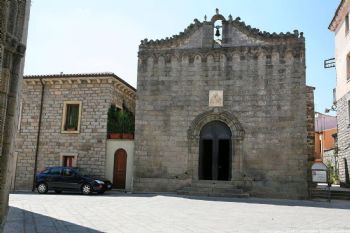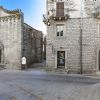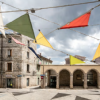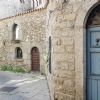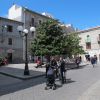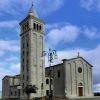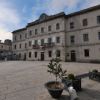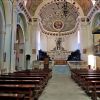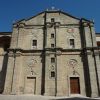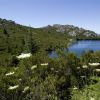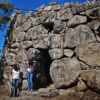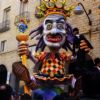
Tempio Pausania
fascino che avvolge il centro storico e i suoi dintorni
It is a very ancient story told by Tempio Pausania that brings back to the Neolithic age, witnessed by megalithic circles, dolmens and nuraghe still well preserved and can be visited in the surrounding area, on all the Nuraghe Majori that also allows a beautiful guided tour. Rich in resources and strategically devoted to the control of the surrounding area, Tempio Pausania is immediately recognized as the main center of the Gallura hinterland and a city of reference and guide for all the Municipalities of the entire area.
The toponym Templum appears for the first time in an ecclesiastical document of 1173 and seems to be linked to the latin templum, in the meaning of slope or escarpment.
More certain is the origin of the name Pausania, derivation of Pasana, a small town near the city of Olbia and home to the ancient diocese. The name of Villa Templi dates back to the 1300s, as a rural center of the Giudicato di Gallura, to cover the role of the curator of the territorial district of Gemini. In 1506, thanks to the unification of the dioceses of Civita and Ampurias, Tempio became a bishop's seat, adding to its political importance also a role in the religious field of the foreground. It is in the seventeenth century that the Institution of the High Schools of the Piarist Fathers dates back, confirming the ever increasing importance of this center. Now the capital of a vast province and seat of the Prefecture, King Carlo Alberto of Savoy granted the City Hall honors and the administrative dignity of the city to Tempio in 1837.
At the beginning of the twentieth century there was a strong increase in population, due to the increase in the activities that animated the Temple, with the gradual abandonment of the stalls towards the city, bringing a building development of considerable proportions.
Currently Tempio Pausania, after sharing with Olbia its centrality with the recognition of the capital until the existence of the Provincial institution, is one of the most industrialized centers of the island, renowned for the processing of raw materials such as granite, cork and the wine.
To visit the Mount Limbara with its countless perfectly traced paths, paradise for lovers of walks and excursions. Here, from the granite sources of Rinaggiu, flows a mineral water with a high content of silica, which crosses the granitic rock to deposit all impurities, to reach impoverished minerals and with ideal properties for natural therapeutic treatments.
Nearby you can visit the village of Bassacutena closely linked to the figure of Giuseppe Garibaldi, the hero of the two worlds. Here in Bassacutena, in fact, Garibaldi started in 1849 and established a strong bond of friendship with a family in the area who lived in a typical farmhouse near the town. At that time the hero of the two worlds covered the mandate of parliamentary legislature of the tenth legislature and, among the various projects that followed, was also involved in the modification of the route of the Temple-Palau road, an intervention that brought development to this area, allowing the emergence of the first craft activities. In Bassacutena stands the church of San Pietro, dating back to 1931, the theater of the patronal feast of 29 June, and the church of Santa Maria de Lu Macchjetu, dating back to the late Middle Ages and located two kilometers from the town; the festivities take place on the last Sunday of July, during which the suprastantia is organized, a particularly participated country fair.
A few kilometers in the direction of Olbia, along a well-marked deviation, rises the beautiful town of Nuchis, another small hamlet of Tempio Pausania. Inserted within a thick wood of cork, characterized by important granite formations, Nuchis dates back to the year one thousand and in 177 obtains the municipal autonomy, subsequently suppressed due to a strong demographic depression. It currently has about 400 inhabitants who live the full serenity of a small charming village with ancient and prestigious historical evidences still evident.
Here there are some of the most beautiful churches in Gallura, such as the Church of the Holy Spirit, dating back to the XIII century and built with exposed granite and which houses inside two precious wooden crucifixes of the seventeenth century. and a painting by Giovanni Marghinotti depicting Pentecost dating from the 19th century. Nearby stands the church of Saints Cosma and Damiano which incorporates the same characteristic of granite construction, built in 1529. In the small inhabited area there is also the small church of Santa Croce of the seventeenth century that has a gabled façade with a bell gable and the church of San Salvatore, with exposed granite ashlars, dating back to 1891.
In the surroundings of Nuchis one visits the nuragic site of Agnu, the sacred source of Li Padadini and the tomb of the Giants sa Pascaredda.
In Nuchis station, the Trenino Verde line runs between Sassari and Palau in one of the most suggestive naturalistic courses in Sardinia.
su carrasciali timpiesu
Tempio Pausania has a long tradition linked to the carnival called su carrasciali timpiesu. His representative figure is His Majesty King George, icon of the evils of the city and of local life. The rite begins six days before Shrove Tuesday, when it is hailed, honored and adulated, up to its trial, during which all his faults are recognized and burned on the public square. Another ancient tradition is Lu Palu of la Frisgjola, the palio in which the galloping riders must take a long pancake, the frisgjola, held to dangle by a masked girl facing a balcony. If the knight succeeds in the enterprise, he can spend an evening in the company of the girl.
- Related products
- Agriturismo Agricamping La Cerra






